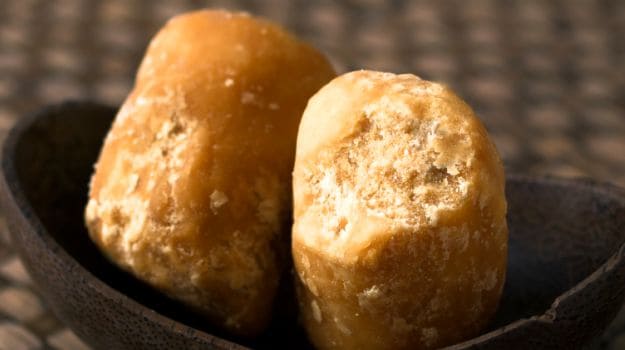Jaggery is made using traditional methods of pressing and distilling palm or cane juice. This is a 3-step process (3):
- Extraction: The canes or palms are pressed to extract the sweet juice or sap.
- Clarification: The juice is allowed to stand in large containers so that any sediment settles to the bottom. It is then strained to produce a clear liquid.
- Concentration: The juice is placed in a very large, flat-bottomed pan and boiled.
During this process, the jaggery is stirred and the impurities are skimmed off the top until only a yellow, dough-like paste remains.
This "dough" is then transferred to molds or containers where it cools into jaggery, which looks something like this:

The color can range from light golden to dark brown. This is important, since the color and texture are used to grade the jaggery.
Interestingly, Indians value lighter shades more than darker ones.
This lighter, "good quality" jaggery generally contains more than 70% sucrose. It also contains less than 10% isolated glucose and fructose, with 5% as minerals (4).
It is most often sold as a solid block of sugar, but it's also produced in liquid and granulated forms.
BOTTOM LINE:Jaggery is made by evaporating the water from sugar cane juice or palm sap. It is sold as a block, liquid or granules.Is It More Nutritious Than Sugar?
Jaggery contains more nutrients than refined sugar because of its molasses content.
Molasses is a nutritious by-product of the sugar making process, which is usually removed when making refined sugar.
Including the molasses adds a small amount of micronutrients to the final product.
The exact nutrition profile of this sweetener can vary, depending on the type of plant used to make it (cane or palm).
According to one source, 100 grams (half a cup) of jaggery may contain (4):
- Calories: 383.
- Sucrose: 65–85 grams.
- Fructose and glucose: 10–15 grams.
- Protein: 0.4 grams.
- Fat: 0.1 grams.
- Iron: 11 mg, or 61% of the RDI.
- Magnesium: 70-90 mg, or about 20% of the RDI.
- Potassium: 1050 mg, or 30% of the RDI.
- Manganese: 0.2–0.5 mg, or 10–20% of the RDI.
However, keep in mind that this is a 100-gram (3.5-oz) serving, which is much higher than you would generally eat at once. You'd probably consume closer to a tablespoon (20 grams) or teaspoon (7 grams).
Jaggery may also contain small amounts of B vitamins and minerals, including calcium, zinc, phosphorus and copper (4).
One commercially available product, SugaVida, is a granulated palm jaggery that is claimed to be a good source of naturally occurring B vitamins.However, It's Still Mostly Sugar
Compared to refined sugar, jaggery appears nutritious. Refined white sugar contains only "empty calories" — that is, calories without any vitamins or minerals (5).
Gram by gram, jaggery is more nutritious than sugar. However, there is a big "but" when it comes to describing it as nutritious.
It's essentially still sugar, and any extra nutrients you get come with a lot of calories.
You would also need to eat a lot of jaggery to get a meaningful amount of these nutrients, which you can get in much greater amounts from other sources.
So, while it may be slightly "healthier" to replace refined sugar with a sweetener that has more vitamins and minerals, it's not really advisable to add jaggery to your diet.
BOTTOM LINE:Jaggery may have a better nutrition profile than sugar, but it's still high in calories and is best consumed in moderation.
Comments
Post a Comment